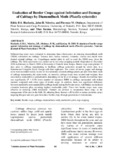| dc.identifier.citation | Eddie B.S. Hasheela, John H. Nderitu, and Florence M. Olubayo;Tunisian Journal of Plant Protection 99 Vol. 5, No. 1, 2010 Evaluation of Border Crops against Infestation and Damage of Cabbage by Diamondback Moth ( Plutella xylostella ) ; Journal of Plant Protection 99 Vol. 5, No. 1, 201 | en |
| dc.description.abstract | Hasheela, E.B.S., Nderitu, J.H., Olubayo, F.M., and
Kasina, M. 2010.
Evaluation of border crops
against infestation and damage of cabbage by
diamondback moth (
Plutella xylostella
). Tunisian
Journal of Plant Protection 5: 99-105.
Different trap crops were evaluated to determine th
eir effectiveness in reducing diamondback moth
(DBM) infestation on cabbage. Tomato, kale, Indian
mustard, coriander, cleome and radish were
planted around cabbage var. Copenhagen market plots
to pull or push the DBM away from the
cabbage. The field experiment was carried out in tw
o relay cropping periods (September to December
2008 and January to March 2009) at University of Na
irobi farm, Kenya. Border crops were planted 15
days prior to cabbage transplanting to facilitate c
abbage protection around the whole plot, in a
Randomized Complete Block Design with four replicat
es. The counts of larvae, pupae and damage
score were recorded weekly in situ on five randomly
selected cabbage plants per plot from third week
of cabbage transplanting for eight weeks. At maturi
ty, cabbage heads were counted and weighed, then
classified as marketable or unmarketable depending
on the level of damage. Results showed that there
was significantly (
P
< 0.05) lower number of immature DBM in cabbage sur
rounded with Indian
mustard compared with other types of border crops.
In addition, there was significant difference
between marketable and unmarketable cabbage heads a
mong the border crops, with Indian mustard and
coriander bordered plots recording highest marketab
le yield. These two border crops were more
effective in reducing DBM infestation. Farmers are
advised to incorporate these crops in the
management of the pest in the field. By adopting th
ese, farmers will be able to reduce pesticide spray
s
targeting this pest and also gain from these border
crops through generation of extra income. | en |

